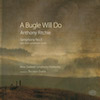

Symphony Number 3
by Anthony Ritchie, for orchestra, Opus 150
Winner of The Supreme Achievement Award by The Listener for 2010, this symphony is bold in colour and gesture, and presents an exciting challenge for the orchestra. It was recorded for the CD A Bugle will Do by the New Zealand Symphony Orchestra, and was premiered at the Otago Festival of Arts by The Southern Sinfonia.
- DURATION: 30 minutes
- INSTRUMENTATION: Piccolo, 2 flutes, 2 oboes, cor anglais, 2 clarinets n B flat, bass clarinet, 2 bassoons, 4 horns in F, 3 trumpets in C, 2 trombones, 1 bass trombone, tuba timpani (4), 3 percussionists playing tom toms, bass drum, tam tam, suspended cymbal, crash cymbals, xylophone, glockenspiel, log drum, harp, electronic keyboard (playing organ), strings
- LEVEL: 3 | Professional and semi-professional musicians
Programme Note
Symphony No.3 was composed as part of Anthony Ritchie's work at the University of Otago, in Dunedin, New Zealand. It was written over a period of two years between 2008-2010. The composer wishes to acknowledge the support of the University of Otago in writing this symphony.
This symphony is a portrayal of two sides of human personality, represented by the two movements of the work: 'Up' and 'Down'. The music depicts the constant struggle to find balance in one's life, in terms of mood and relationships with other people.
Movements:
I - UP - allegro furioso - very still - tempo I
II - DOWN - adagio pesante - allegro con fuoco - slower, misterioso - largamente - slow and expressive
Broadly speaking, 'Up' is active, busy, vibrant in mood. Musical motifs and themes emphasize upward progressions, while the orchestration is lively and colourful. Full of blazing brass and high-pitched woodwind, 'Up' is associated with images of the sun, and outdoors activity. Percussion play an important role rhythmically, especially the combination of log drum and tom toms. Eventually the lively character of the music loses control, leading to a riotous climax involving the percussion and full orchestra in unison. The music disintegrates into a short oasis of calm, before the busy mood is gradually re-established, and brings the movement to an end, on a bright sounding D Lydian chord.
'Down', by contrast, is melancholic, slow and mournful in mood. If 'Up' is associated with the sun, then 'Down' is associated with Saturn. There is also reference made to Durer's famous woodcut, 'Melancholia' (1514), in which a magic square appears. The numbers on this square are used to generate themes and ideas in this movement - the opening piccolo melody, underpinned by wispy strings, for example. A second theme, featuring tuba and bass trombone, refers to a 'tuatara' theme written by the composer in 1991, and here is ponderous in tone. Following a gradual buildup a faster section emerges, full of tension and unresolved progressions. The angry protests subside, and a mysterious passage recaps the first theme, accompanied by constantly shifting strings. Out of the depths emerges a bass clarinet, playing a bird-like theme, which is picked up by the other woodwinds in a fugue, which refers back to the earlier quick section. After a brief silence, the second theme reappears but this time in a passionate, full-blooded version that leads to a tense climax. The music searches for resolution, and eventually finds it in a lyrical coda for strings alone, to start with. Themes from earlier in the symphony are transformed, and the overall key centre, D, is hinted at but never quite reached. The chiming of a clock suggests the never-ending passing of time, and the log drum, so prominent in the first movement, returns to conclude the work.
Structurally, 'Up' has elements of sonata form which become increasingly loose as the movement progresses. 'Down' is symmetrical in arrangement, with the mysterious section forming the centre of the following form A-B-C-D-C-B-A (+ coda).
Dedicated to Sandy
A hardcopy study score is available from Promethean Editions. Conductors and orchestra managers should get in touch with us directly this month to receive a free digital perusal score. Email: bellbirdpublications at gmail.com
Buy the right to download a single pdf containing all parts, online, and permission to duplicate or print it as required for one orchestra : NZ$100.00 (currently about US$63).
|
Orders are saved in a secure Paypal shopping cart which is viewed on a separate browser tab. When you have finished shopping, simply Check Out for a Secure Guest check out using your credit card, or to use an existing Paypal account choose Paypal Check Out. Orders are processed every 5 minutes. An email with a link to each file should arrive within 6 minutes of checking out. If it does not arrive we will likely notice during a New Zealand working day but please send an email to bellbirdpublications at gmail dot com if you have any problems with ordering. |

